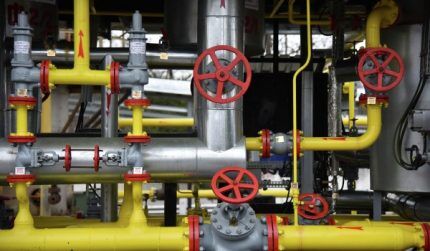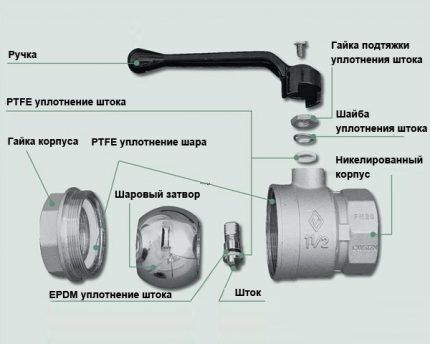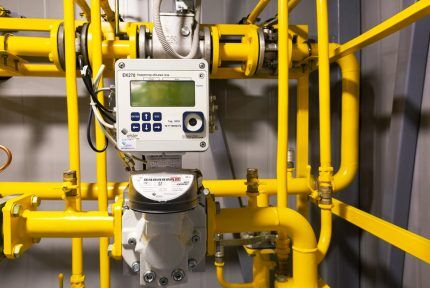Gas fittings and equipment: varieties + features of choice
A gas pipeline is an engineering structure, each element and node of which solves an important specific functional task and is responsible for the safety, quality and uninterrupted functioning of the network.A variety of gas fittings and equipment vary in complexity of design, material of manufacture, purpose and type.
Fittings for gas pipelines are a broad class of fixtures and devices that are mounted on gas pipelines, as well as on devices. With their help, switching off/on, changing the direction, quantity, pressure of the gas flow or completely removing gases are carried out. A wide range of these parts are classified, thanks to which you can quite easily understand the issue of classifying gas fittings.
Let's look together at the variety of fittings for gas pipelines and the features of their selection.
The content of the article:
- Purpose of gas fittings and equipment
- Classification of fittings for gas pipelines
- Symbols for gas fittings
- Features of shut-off valves
- Connecting fittings for gas pipelines
- Instrumentation and automation devices in gas pipeline systems
- Features of choosing fittings and equipment
- Conclusions useful video on the topic
Purpose of gas fittings and equipment
Gas fittings and gas equipment are intended for installation on pipelines used for transportation, supply and distribution of blue fuel. With the help of these mechanisms, the supply, pressure, quantity, and direction of the gas flow are turned on and off. The valves have such basic characteristics as nominal pressure (nominal) and nominal diameter.
Under nominal pressure is taken max pressure at a temperature of 20 degrees, at which a long service life of various connections of elements and assemblies with the pipeline is guaranteed.Conditional diameter (DN) is a characteristic that is used in pipeline networks as a general parameter of the connected parts.

Most types of fittings consist of a shut-off or throttle device. These are structures in the form of a housing closed on the outside with a lid.
The shutter moves inside the body. As a result of the movement of the valve relative to its seats, the area through which the gas passes changes. This process causes a change in hydraulic resistance.

The surfaces of the valve and seat that come into contact during shutdowns of parts of the gas pipeline are called sealing surfaces. In throttle-type devices, the surfaces of the valve and seat, which, in turn, form a controlled passage for transporting the working medium, are called throttle surfaces.
Classification of fittings for gas pipelines
All existing types of gas fittings, depending on their purpose, can be divided into:
- shut-off valve. Fittings used for periodic shutdowns of individual sections gaswires, devices, equipment. This type includes gas taps, gate valves;
- safety. Serving to prevent the risk of gas pressure increasing above established standards. This type of valve includes a relief safety valve;
- regulating. Designed to change and maintain pressure within specified limits. These are dampers, gates, etc.;
- reverse action. To prevent changes in the direction of gas movement;
- emergency and cut-off. For quick auto-termination gas movement towards the emergency area in case of violation of the specified regime. This type includes a shut-off safety valve;
- condensate drain. The one that deletes in automatic mode, condensate accumulating in condensation- collectors and lower sections of pipeline networks;
- test. Determines the pressure of the mass being passed, temperature, etc.
According to the control method, the valves can be of two types: controlled And automatic. The first is activated by manual manipulation or using a drive: pneumatic, hydraulic, electromagnetic, electric.
The manual process involves a lot of effort and waste of time. It is much more common to install a drive and retain the possibility of emergency control in case of accidents. And the second operates using devices automatic triggering.

According to the method of connection, equipment and any fittings for gas supply systems are:
- flanged — used for fittings with a passage for a medium greater than 50 mm. Connection to pipes is carried out by screwing flanges. The main advantage of such a connection is the possibility of multiple reinstallations, greater strength and reliability. You can also note its universal applicability. The only drawbacks are the large mass and large dimensions of such parts;
- coupling — used to connect equipment with a passage of 65 mm or less.The connection is made using couplings with threads located on the inside. The disadvantage of coupling connections is that the threads gradually wear out;
- pin-type with cut external thread. One device is threaded into another device;
- welding - these are rarely used today non-separable connections. The advantages of this method are reliable tightness and minimization of maintenance activities. The disadvantages include the difficulty of dismantling the connection when repairs are necessary, when a section of the gas pipeline is simply cut off;
- nipple — the fittings are connected using a nipple;
- coupling — the pipes are connected to the pipe flanges with studs and nuts, which are located along the fittings;
- fitting — the fittings are connected using a fitting, a union nut and o-rings. This is a reliable connection method with the ability to dismantle.
In addition to those listed above, there are other methods of connecting gas fittings, but they are not used so often.

Also, do not forget that the functionality of the pipeline and the reliability of the entire gas distribution system will depend on the quality of the connection.
Symbols for gas fittings
The fittings used in the gas industry are standardized. Each part must have a code consisting of 4 parts.
The first 2 digits of the code are the type of reinforcement:
- 11 — taps for pipelines;
- 14,15 - shut-off valves;
- 16 — check lift valves;
- 17 — safety valves;
- 19 — check rotary valves;
- 25 - control valves;
- 30, 31 - shut-off valves;
- 32 - gates.
In second place in the code is the symbol for the case material: carbon steel - c, acidicresistant stainless steel - nzh, gray cast iron - h, malleable cast iron - kch, bronze, brass - br, vinyl plastic - vp, alloy steel - ls, aluminum - a.

The third place in the code is the serial number of the part. On the fourth is the designation of the material from which the sealing rings are made: bronze or brass - b, stainless steel - nzh, rubber - r, ebonite - e, babbitt - bt, no sealing rings - bk.
Features of shut-off valves
Shut-off valves are most often found in gas systems. It is used to adjust gas pipeline pressure and operates on the same principle as in water pipelines. However, parts in the gas industry are subject to higher safety requirements.
If the concentration of gas in the air reaches a critical value, then just the slightest spark is enough and a real disaster can occur.
Based on the type of movement of the functional mechanism, shut-off valves for gas pipelines are divided into the following types:
- tap – in a crane, a locking element with a body of rotation moves while simultaneously rotating around its axis. Can be positioned arbitrarily relative to the direction of flow;
- gate — in this part, the disk-shaped element rotates around its axis at an angle or perpendicular to the flow;
- valve – in the part, the locking body on the spindle moves back and forth parallel to the flow;
- valve – in it the adjustment element moves perpendicular to the flow.
It can be summarized that shut-off valves include devices that are intended to hermetically shut off sections of a gas pipeline. These devices must guarantee tight shutdown, speed of action, low hydraulic resistance and ease of maintenance.
Operating principle of the valve
Most often, valves can be found on pipelines made from different types of shut-off valves for gas equipment. They are used when it is necessary to shut off the gas flow in gas pipelines with nominal diameters from 50 mm to 2000 mm, when the operating pressure is in the range of 0.1–20 MPa.
In valves, gas flow is controlled by changing the position of the valve relative to the sealing surfaces. Spindle non-retractable When opened, it does not come out of the lid. When it rotates to open the hole, the running nut is screwed onto it, raising or lowering the bolt. In this type of valve, the running unit is located inside the working environment, so it is more susceptible to the negative effects of corrosion.
Equipment with a retractable spindle moves the spindle and shutter by rotating the threaded sleeve, while the upper part of the spindle extends upward. The advantage of this design is the absence of influence of the external environment on the running unit.
Valves differ in their locking design into 2 types. Wedge valves have a valve with sealing surfaces located at a certain angle to each other. They are also produced with a hinged valve, consisting of 2 disks and a solid wedge. Parallel valves have a gate consisting of 2 disks, between which there is a spacer wedge.

For gas pipelines designed for pressures up to 0.6 MPa, valves made of gray cast iron are used; for gas pipelines that use pressure under pressure greater than 0.6 MPa, valves are made of steel.
But what are the advantages of gate valves in comparison with other shut-off valves? In the open position, there is little resistance to flow, and there is no rotation of the gas medium. The valves have a short face-to-face length. They are easy to maintain and provide the ability to move gas in any direction.
Dampers can be distinguished separately in this category. They refer to shut-off and control equipment, thanks to which gas flow is regulated, and it is also possible to stop its supply in the gas pipeline. The dampers consist of a body, a shut-off disc body, and a drive shaft.
Dampers can be used in a wide range of ambient temperatures or pressures. They have a simple design, low weight and low metal consumption. The dampers have a short overall length and a minimum number of elements. Their big advantage is their affordable price.
The pressure on modern gas pipelines is monitored by many sensitive sensors that record the slightest deviations and transmit information about them to the dispatcher’s control panel.
What are taps for?
In addition to the above devices, shut-off valves include taps and valves necessary for quickly connecting/disconnecting the device or regulating the flow of the working medium. These parts can be divided into spherical, cylindrical, and conical according to the shape of the shutter.
To achieve higher sealing in the tap, a special grease is injected under pressure between the sealing surfaces.It is tucked into a hollow channel in the upper part and, by screwing in a bolt, is pressed through the channels into the existing gap between the plug and the body.

The plug rises slightly, increasing the gap and making it easier to turn. The brass gasket and ball valve prevent lubricant from being squeezed out with subsequent gas leakage.
In addition to taps that require lubrication, simple rotary taps are used in gas pipelines. They can be divided into tension, stuffing box, and self-sealing. They can be installed on above-ground gas pipelines, on-site gas pipelines, on auxiliary lines (on purge gas pipelines, etc.).
Condensate collectors and compensators
To collect and remove water and condensate at the lower levels of gas pipelines, install condensate collectors.
They can be of different capacities: a larger capacity is necessary if the transported gas has high humidity, a smaller capacity is suitable for transporting dry gas. In addition, depending on the pressure of the passing working medium condensate collectors differ in devices of low, medium, high pressure.
Low pressure devices - this is a container with an inch tube led under the gas carpet. The tube ends with a coupling and a plug. Condensate is removed through it, measured pressure, the gas pipeline is purged.
Medium and high pressure devices additionally equipped with another protective tube and a tap on the internal riser. There is a hole on top of the riser to equalize the pressure of the working medium in the case and in the riser.Without the hole, condensate under gas pressure would fill the riser, which could lead to its rupture at low temperatures.

Under the influence of gas pressure it is carried out auto-pumping condensate When the tap is closed, the gas counteracts the condensate and it slides down. When the faucet opens, condensate rises to the surface.
When operating gas pipelines, the difference in temperature can reach several degrees. Such a large magnitude of change can cause stress of several tens of MPa. Therefore, to ensure normal operation of the gas pipeline, compensators must be used. They can be lens-shaped, U-shaped, lyre-shaped, etc.

Lens and bellows compensators are more common. U-shaped and lyre-shaped expansion joints are made from bent, often seamless pipes. Their main drawback is their large size. On pipelines in mountainous and seismic-dangerous areas are established rubber-fabric devices that are capable of accepting deformations in both longitudinal and transverse directions.
Connecting fittings for gas pipelines
During the installation of a gas pipeline, it may be necessary to connect pipes of different materials or different diameters. In this case, a connecting flange element is built into the network - auxiliary joining parts.
This category of fittings includes flange adapters, clamps, plugs, couplings, bends, crosses, tees, in short, parts whose design does not provide for a locking and control mechanism.

Tees and bends are used to branch the gas pipeline. They are installed in cases where the pipe reaches the distribution section for a populated area, but this point is not the final point.
With the help of control valves, the pipeline is divided and part of the transported gas goes to the populated area, and part is transported further.

Devices instrumentation and automation in gas pipeline systems
In addition to all of the above, numerous devices are used in gas pipeline systems Instrumentation and automation (instruments and automation).

The most popular devices used in gas systems are:
- gas alarms;
- equipment for emergency shutdown of incoming gas;
- equipment for measuring the volume of gas passed through;
- electronic regulators of the gas volume passed;
- autonomous power supplies;
- gas valves for automating various processes and optimizing the operation of pipelines;
- gas regulators for regulating the volume of medium passing through some section of the pipeline.
Such devices are high-tech equipment used in a wide variety of conditions.
Features of choosing fittings and equipment
Choosing fittings for gas pipelines You should pay special attention to the chemical and physical properties of the material from which it is made.
The most popular materials for the manufacture of gas fittings are cast iron and steel. This is due to the requirements for an increased level of strength and reliability. Polymer elements, which are excellent for water pipelines, are not applicable here; in addition, they can be easily damaged.

Experts do not recommend using equipment with bronze sealing inserts on gas pipelines. This is due to the fact that LPG contains hydrogen sulfide, which can have a negative effect on bronze and copper alloys.
Conclusions useful video on the topic
You can learn how to maintain shut-off valves on a gas pipeline from the following video:
The design features of wedge and hose valves will be discussed in this video:
All gas pipelines are considered high-risk objects, so the choice of gas fittings and equipment should be taken seriously, and, if necessary, consult with specialists. Only high-quality gas shut-off valves can ensure ease of maintenance, speed of repair, and high tightness of pipeline components.
If you have questions about the topic of the article, or can add interesting information to our material, please leave your comments in the block below.



